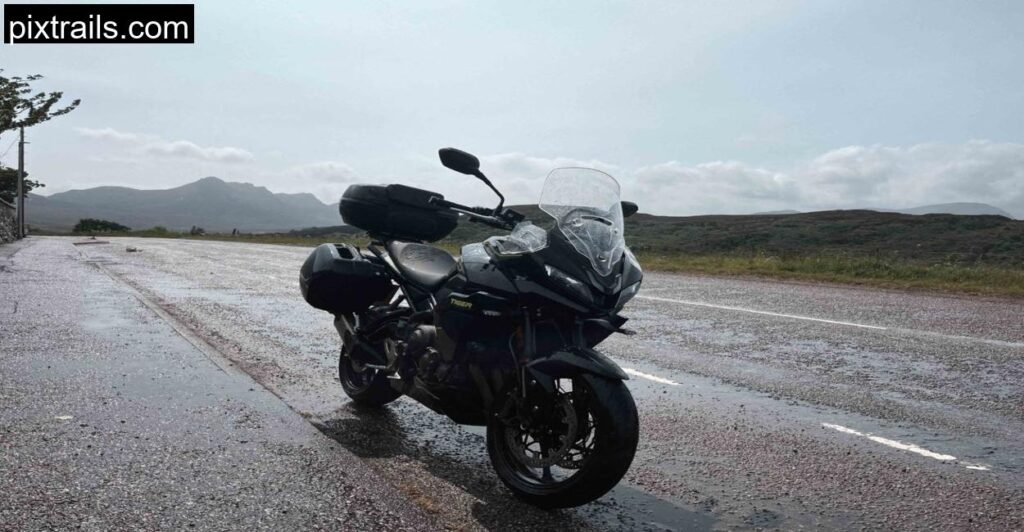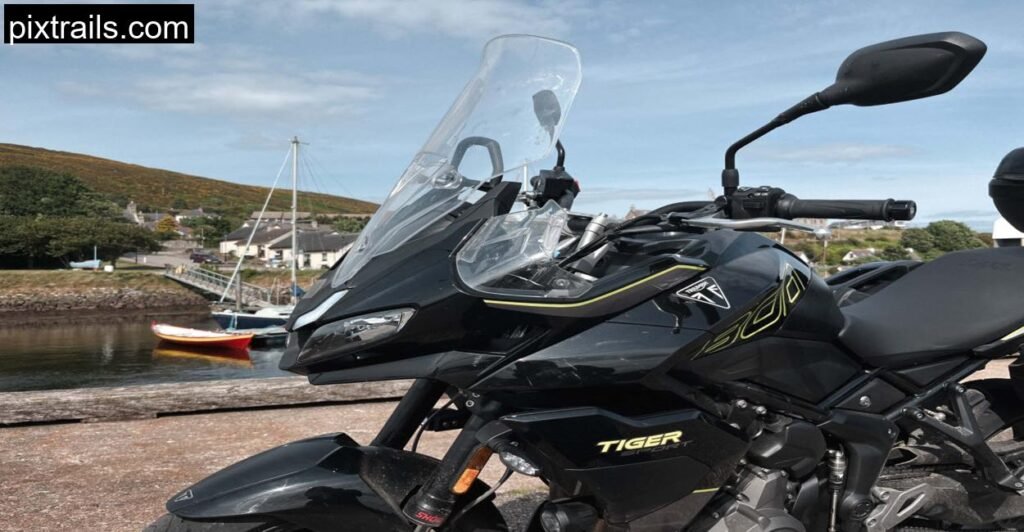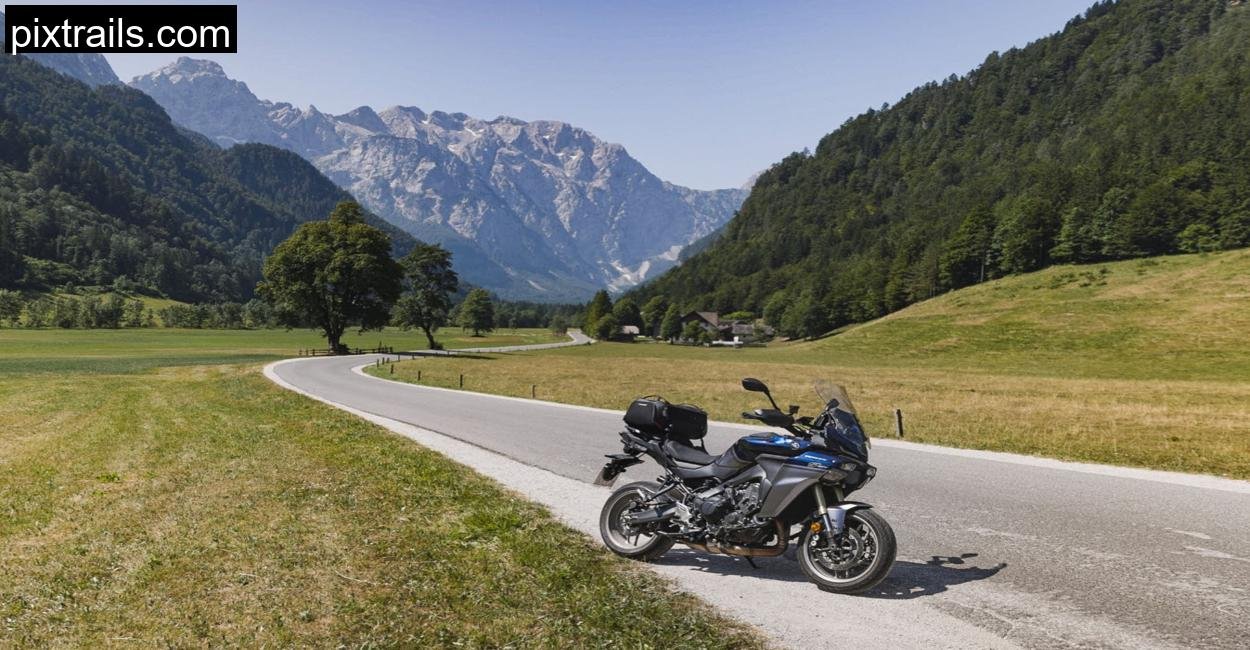The Triumph Tiger Sport 800 isn’t just a motorcycle on paper. It’s a promise, the kind of machine you look at and imagine crossing countries on, your luggage strapped neatly, your visor reflecting mountains, coastlines, and the unpredictable sky. My testing ground for this bike was Scotland, 2,000 km across 11 days, but the mindset I carried into the trip was shaped by a memory of Alta Badia in Italy.
Why Alta Badia? Because that part of the Dolomites teaches you something about what a touring bike must be. The roads sweep like brushstrokes, the altitudes change quickly, the air shifts from warm to biting cold in minutes. You learn that comfort, agility, and power aren’t luxuries, they’re survival tools for a rider who wants more than a straight road. I carried that understanding into the Highlands of Scotland, knowing this Tiger Sport 800 would have to prove it could handle not only the numbers in its spec sheet but also the merciless, shifting moods of real travel.
First Impressions – A Sports Tourer with Travel in Its Blood
Standing beside the Triumph Tiger Sport 800 for the first time, it didn’t scream off-road adventure like its taller Tiger siblings. It had a sharper, more road-focused stance, a reminder that Triumph wasn’t trying to make this into a dirt conqueror. This was for long asphalt journeys, spirited cornering, and hours in the saddle without groaning when the sun dipped and the temperature dropped.
The bike sat on 17-inch wheels front and rear, with a body that looked slim for a tourer, almost deceptive in how manageable it appeared for something meant to haul two riders and luggage across unpredictable terrain. The tall screen, adjustable by hand, and the slightly aggressive but comfortable riding position immediately felt promising. My mind went to the long straights of the North Coast 500 in Scotland, could this be the sweet spot between agility and comfort that so many sports tourers fail to nail?
Technical Specifications – Triumph Tiger Sport 800 (2025 Model)
All information provided here is based on the Triumph’s official specifications. Any changes or updates can be found directly on their website.
| Specification | Detail |
| Engine Type | 798 cc, liquid-cooled, inline 3-cylinder |
| Power Output | 115 hp @ 10,000 rpm |
| Torque | 84 Nm @ 8,000 rpm |
| Gearbox | 6-speed with quickshifter |
| Frame | Steel perimeter frame |
| Front Suspension | Showa USD forks, 150 mm travel |
| Rear Suspension | Showa monoshock, adjustable preload & rebound, 150 mm travel |
| Wheels | 17-inch cast aluminum (front & rear) |
| Brakes | Dual 320 mm discs with radial calipers (front), single 255 mm disc (rear) |
| Seat Height | 835 mm |
| Fuel Tank Capacity | 18.5 liters |
| Kerb Weight | 218 kg (approx.) |
| Electronics | Riding Modes (Rain, Road, Sport), Cornering ABS, Traction Control, Cruise Control |
| Optional Features | Heated grips, fog lights, luggage system |
| Average Fuel Consumption | 4.7 L/100 km |
| Estimated Range | ~390 km |
Engine Character – Three Cylinders of Smooth Determination

The heart of the Tiger Sport 800 is its 798 cc three-cylinder engine, and honestly, this is where Triumph shows off its engineering finesse. I’d ridden bikes where the spec sheet promised smooth torque delivery but reality brought awkward power spikes or low-end dullness. The Tiger wasn’t one of them.
On Scottish A-roads, rolling the throttle from 3,000 rpm brought a steady, predictable pull. The bike didn’t need to be screamed into the red to feel alive, but if you did climb past 7,000 rpm, it rewarded you with that distinctive three-cylinder growl, urgent but not frantic. In Sport mode, throttle response sharpened noticeably without becoming twitchy, making it perfect for overtakes on short, clear stretches between blind bends.
The best part? Vibration, or rather the lack of it. After hours on the saddle, the absence of numbing buzz in the handlebars or footpegs became one of those understated luxuries that you only truly appreciate on day four of a trip, somewhere in the drizzle north of Ullapool.
Chassis and Handling – Balanced for the Real World
Scotland isn’t a place that forgives poor suspension setup. One hour you’re leaning through perfect sweepers along the coast, the next you’re dodging potholes carved by years of frost and rain. The Tiger Sport 800’s Showa suspension, 150 mm travel front and rear, struck a rare balance between comfort and road precision.
In the Highlands, single-track roads often have a camber that shifts under you mid-corner. Here, the 17-inch wheels and neutral steering paid off. The bike wasn’t hypersensitive, but it responded willingly to mid-corner corrections without feeling unsettled. Even with the panniers fully loaded and a top box behind me, stability was reassuring, though I did notice that at higher motorway speeds, straight-line stability wasn’t its strongest suit, likely the short wheelbase and aerodynamic drag from the luggage.
Braking performance was faultless. The radial-mounted calipers had a firm, progressive bite that inspired confidence in both dry and rain-soaked conditions. ABS intervention felt natural, never intrusive, and cornering ABS added that extra layer of calm when braking late into bends slick with Scottish mist.
Comfort and Ergonomics – A Bike You Can Live On

One thing I’ve learned from touring is that even the most thrilling bike becomes a burden if your back, wrists, or knees start complaining. The Tiger Sport 800 didn’t give me that problem. The riding position was upright yet leaned slightly forward, enough to feel engaged without putting weight on my wrists. The seat, at 835 mm, was narrow enough at the front for my legs to grip comfortably, and wide enough at the rear to support hours of riding.
Wind protection was good up to shoulder height, but taller riders over 1.85 m will want a screen extension. The seat padding felt right, not overly plush but not punishing either. My pillion had no complaints even after consecutive 200+ km days, credit to the generous seat space and relaxed knee angle. Heated grips, which I had opted for, were worth their weight in gold during early mornings when the Highlands’ air bit through my gloves.
Electronics and Touring Features – Just the Essentials
Triumph kept the Tiger Sport 800’s electronics purposeful. Three riding modes, Rain, Road, and Sport, genuinely felt different. Rain mode softened throttle response noticeably, making it invaluable when roads turned into glistening ribbons of caution.
Cruise control worked reliably, though the absence of a “resume last speed” button was mildly annoying on long motorway runs. Traction control was effective but perhaps too conservative, cutting in earlier than I’d like even in Sport mode when accelerating out of lean. Still, for a touring bike meant to keep you safe in all conditions, this made sense.
The luggage system felt well integrated. Side panniers didn’t make the bike overly wide, and the top box swallowed two helmets with ease. The preload adjustment via a handwheel was a godsend when switching between solo riding and full two-up touring.
Real-World Touring – Scotland in All Its Moods
The route across Scotland gave the Tiger every type of test: damp coastal curves on the North Coast 500, wind-lashed straights on the way to John o’ Groats, and narrow Highland passes where sheep, potholes, and sudden fog became equal hazards.
In heavy rain, the bike remained planted, its Michelin Road 5 tires living up to their reputation for wet grip. On sunnier afternoons, the Tiger felt light-footed enough to enjoy quick cornering without ever feeling like it was straining against its touring role.
Fuel consumption averaged 4.7 L/100 km, giving me nearly 390 km before the tank needed a refill, an important figure when remote Scottish fuel stations could be 80 km apart.
Conclusion – The Tiger That Likes Asphalt
By the end of the 2,000 km trip, I had no doubts: the Triumph Tiger Sport 800 isn’t pretending to be an all-terrain giant. It’s an asphalt-loving tourer with just enough suspension travel to handle the rough bits life throws at you on a long ride. The three-cylinder engine is a gem, the ergonomics are spot-on for hours in the saddle, and the features are exactly what you need without drowning you in tech.
It’s not perfect, taller riders will crave better wind protection, and high-speed stability with a top case isn’t bulletproof, but in the grand picture, these are small trade-offs for a bike that blends daily usability with genuine touring muscle.
Is Triumph Tiger Sport 800 suitable for long tours?
Yes. Ergonomics, luggage options, and fuel range make it a capable long-distance companion.
What’s the real-world fuel economy for Triumph Tiger Sport 800?
Around 4.7 L/100 km in mixed touring conditions.
Can Triumph Tiger Sport 800 handle two-up with luggage?
Absolutely, though very tall pillions might feel slightly cramped.










